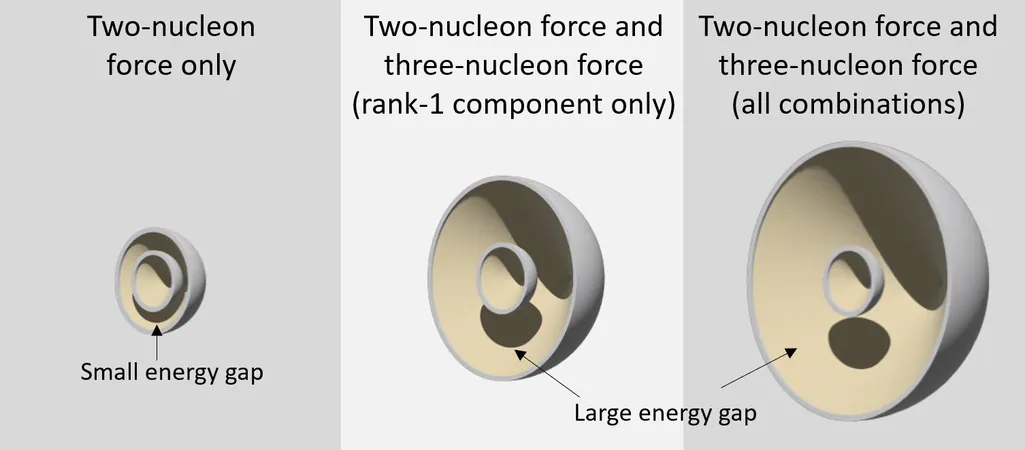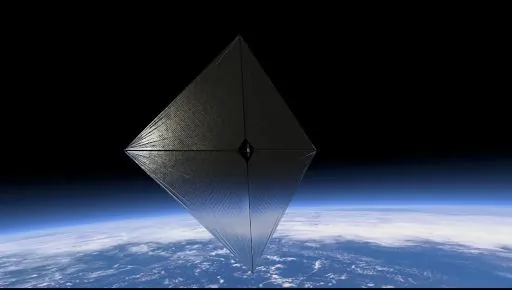
Unveiling the Hidden Nuclear Force: A Breakthrough Study on Matter Stability!
2025-01-28
Author: Wei Ling
Introduction and Significance
Groundbreaking research from Kyushu University in Japan has unveiled the significant role of a neglected force within atomic nuclei—the three-nucleon force—in maintaining the stability of matter. Published in the reputable journal Physics Letters B, this study is poised to alter our understanding of nuclear physics and may even shed light on cosmic phenomena such as the formation of heavier elements in stars.
Understanding Nucleons and Forces
Atoms, the fundamental units of matter, comprise a core known as the nucleus, which is densely packed with protons and neutrons—collectively termed nucleons. The quest to comprehend how these nucleons interact has captivated scientists for over a hundred years. Traditionally, the two-nucleon force—the strongest nuclear interaction—has been the focal point, attracting nucleons from a distance while repelling them when they're too close.
The Role of Three-Nucleon Force
However, Tokuro Fukui, an Assistant Professor at Kyushu University, emphasizes the complexities of the three-nucleon force, which involves simultaneous interactions among three nucleons. This mechanism, likened to a game of catch among three players, is far more intricate and has remained poorly understood until this new revelation.
Methodology and Findings
Fukui and his team employed advanced nuclear theories and cutting-edge supercomputer simulations to meticulously analyze the behavior of pions—subatomic particles exchanged between nucleons. Their breakthrough revealed that as three nucleons synchronize their movements through the exchange of two pions, they become constrained in their dynamics, limited to just four possible states. Remarkably, one of these, the 'rank-1 component,' enhances nuclear stability substantially.
Spin-Orbit Coupling
The research highlights a phenomenon known as spin-orbit coupling. When nucleons align their spins and orbits, they energize a particular reduction in energy levels. Conversely, when they operate oppositely, they spiral into higher energy states—this split between energy shells provides the nucleus with much-needed stability.
Implications for Heavier Nuclei
The real jaw-dropper? This three-nucleon force's influence escalates significantly in heavier nuclei. For example, in carbon-12, which consists of 12 nucleons, the energy gap between shells widened by an impressive factor of 2.5, an effect nearly equal to that of the two-nucleon force. The research team is eager to explore this effect's implications for even heavier elements in upcoming studies.
Stellar Processes and Nucleon Stability
Not only does this discovery deepen our understanding of nuclear stability, but it also speaks volumes about stellar processes. The enhanced stability provided by the three-nucleon force makes it increasingly challenging for a nucleus to absorb additional neutrons, critical for the synthesis of heavier elements. This impediment is particularly pronounced in 'magic number' nuclei, with fully filled nucleon shells becoming extraordinarily stable and impeding fusion reactions necessary for generating energy in stars.
Future Research and Applications
Fukui emphasizes the vital role of understanding the energy gap between nuclear shells for predicting the formation of heavy elements. He asserts that comprehending the three-nucleon force is essential for accurately simulating conditions capable of generating colossal energy levels.
Quantum Entanglement and Technology Advancement
The study also unlocked a fascinating aspect regarding spins of nucleons. The researchers discovered that while spin states of two nucleons can be independently measured with only a two-nucleon force, the introduction of the three-nucleon force leads to quantum entanglement among the nucleons, where the spins coexist in both states until they are observed—a concept bearing resemblance to electron behavior.
Conclusion
This cutting-edge research not only expands our horizons in nuclear physics but also hints at potential breakthroughs in quantum technology. Stay tuned as Fukui and his team prepare to delve deeper into this mysterious and complex aspect of atomic interactions, as it could redefine our approach to science and technology!





 Brasil (PT)
Brasil (PT)
 Canada (EN)
Canada (EN)
 Chile (ES)
Chile (ES)
 Česko (CS)
Česko (CS)
 대한민국 (KO)
대한민국 (KO)
 España (ES)
España (ES)
 France (FR)
France (FR)
 Hong Kong (EN)
Hong Kong (EN)
 Italia (IT)
Italia (IT)
 日本 (JA)
日本 (JA)
 Magyarország (HU)
Magyarország (HU)
 Norge (NO)
Norge (NO)
 Polska (PL)
Polska (PL)
 Schweiz (DE)
Schweiz (DE)
 Singapore (EN)
Singapore (EN)
 Sverige (SV)
Sverige (SV)
 Suomi (FI)
Suomi (FI)
 Türkiye (TR)
Türkiye (TR)